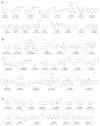Chemoinformatic analysis of combinatorial libraries, drugs, natural products, and molecular libraries small molecule repository
- PMID: 19301827
- PMCID: PMC2686115
- DOI: 10.1021/ci800426u
Chemoinformatic analysis of combinatorial libraries, drugs, natural products, and molecular libraries small molecule repository
Abstract
A multiple criteria approach is presented, that is used to perform a comparative analysis of four recently developed combinatorial libraries to drugs, Molecular Libraries Small Molecule Repository (MLSMR) and natural products. The compound databases were assessed in terms of physicochemical properties, scaffolds, and fingerprints. The approach enables the analysis of property space coverage, degree of overlap between collections, scaffold and structural diversity, and overall structural novelty. The degree of overlap between combinatorial libraries and drugs was assessed using the R-NN curve methodology, which measures the density of chemical space around a query molecule embedded in the chemical space of a target collection. The combinatorial libraries studied in this work exhibit scaffolds that were not observed in the drug, MLSMR, and natural products databases. The fingerprint-based comparisons indicate that these combinatorial libraries are structurally different than current drugs. The R-NN curve methodology revealed that a proportion of molecules in the combinatorial libraries is located within the property space of the drugs. However, the R-NN analysis also showed that there are a significant number of molecules in several combinatorial libraries that are located in sparse regions of the drug space.
Figures








References
-
- Scior T, Bernard P, Medina-Franco JL, Maggiora GM. Large Compound Databases for Structure-Activity Relationships Studies in Drug Discovery. Mini-Rev Med Chem. 2007;7:851–860. - PubMed
-
- Hopkins AL. Network Pharmacology: The Next Paradigm in Drug Discovery. Nat Chem Biol. 2008;4:682–690. - PubMed
-
- Austin CP, Brady LS, Insel TR, Collins FS. Molecular Biology: NIH Molecular Libraries Initiative. Science. 2004;306:1138–1139. - PubMed
-
- PubChem. [accessed Feb 21, 2009]. Available at: http://pubchem.ncbi.nlm.nih.gov.
Publication types
MeSH terms
Substances
Grants and funding
LinkOut - more resources
Full Text Sources
Other Literature Sources
Medical
Molecular Biology Databases

